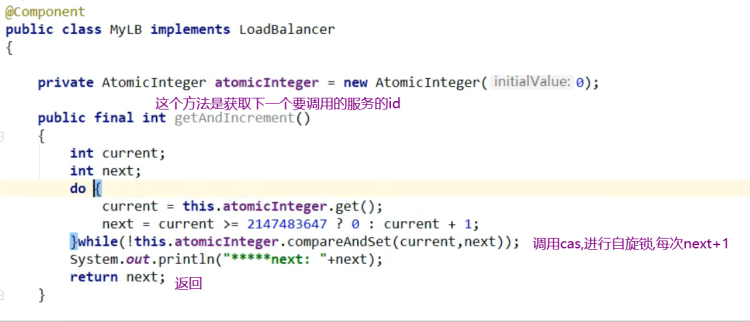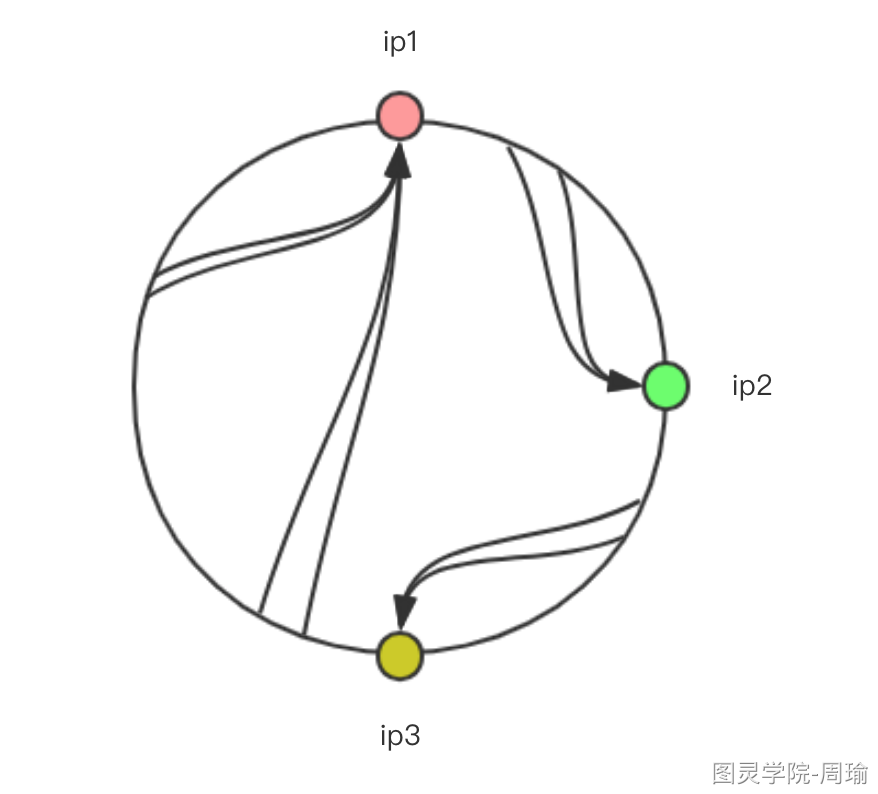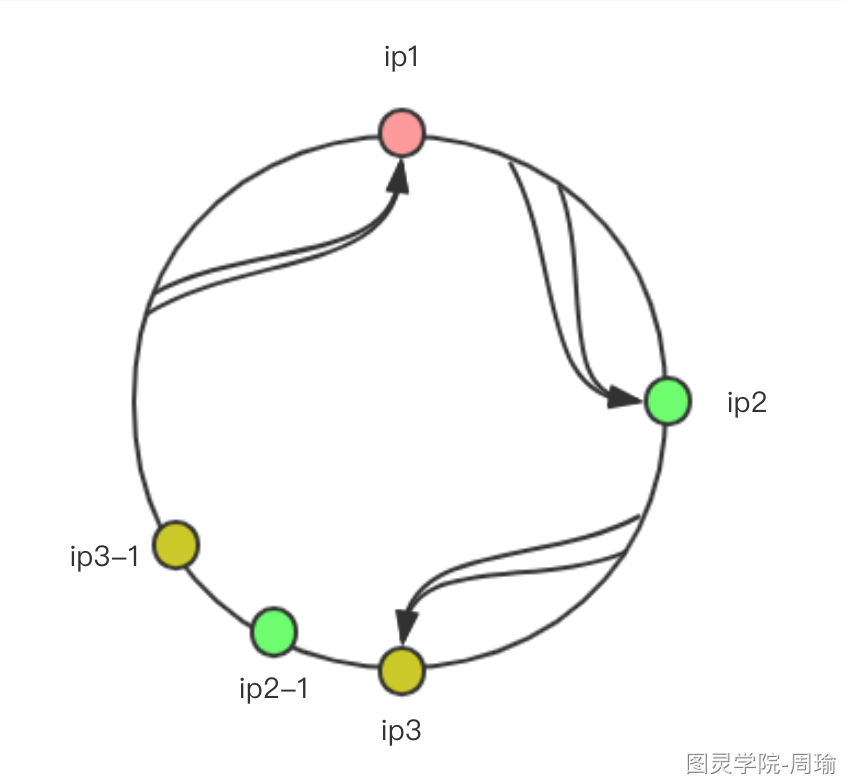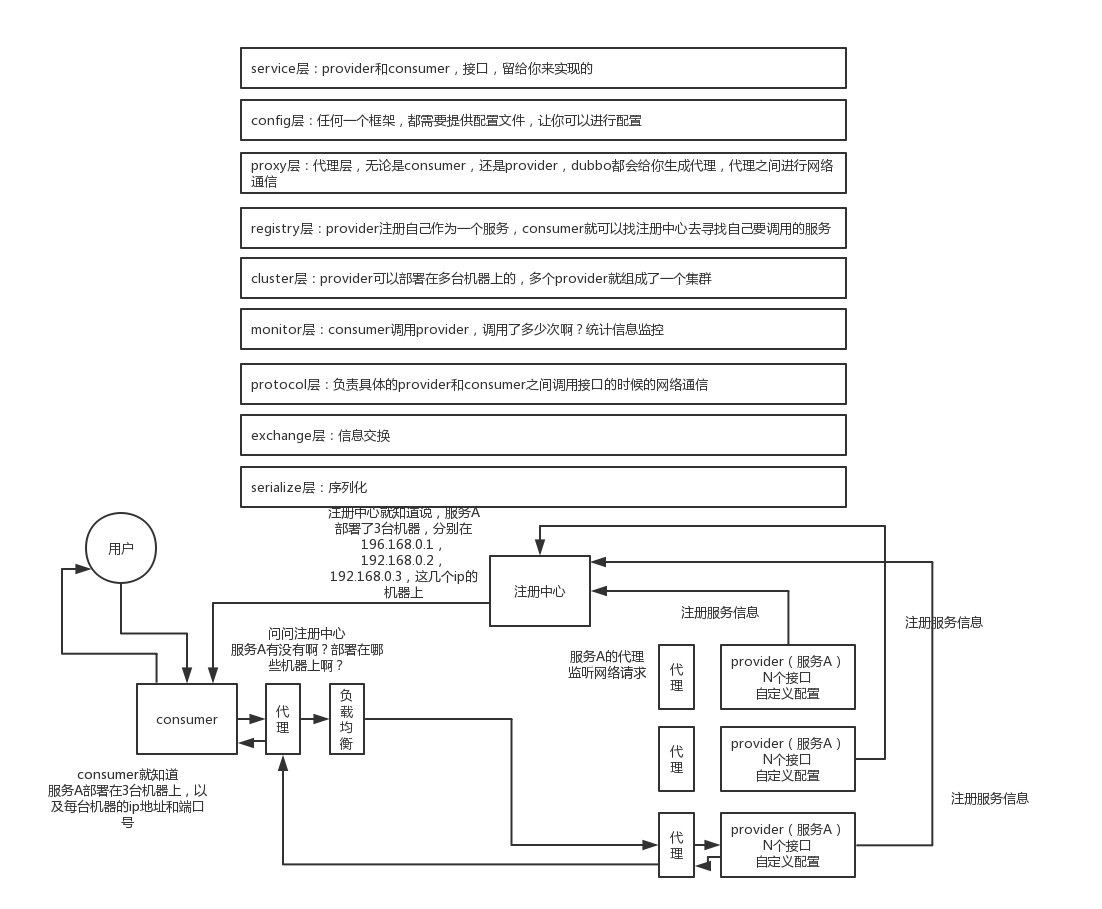工作原理
dubbo 工作原理
- 第一层:service 层,接口层,给服务提供者和消费者来实现的
- 第二层:config 层,配置层,主要是对 dubbo 进行各种配置的
- 第三层:proxy 层,服务代理层,无论是 consumer 还是 provider,dubbo 都会给你生成代理,代理之间进行网络通信
- 第四层:registry 层,服务注册层,负责服务的注册与发现
- 第五层:cluster 层,集群层,封装多个服务提供者的路由以及负载均衡,将多个实例组合成一个服务
- 第六层:monitor 层,监控层,对 rpc 接口的调用次数和调用时间进行监控
- 第七层:protocal 层,远程调用层,封装 rpc 调用
- 第八层:exchange 层,信息交换层,封装请求响应模式,同步转异步
- 第九层:transport 层,网络传输层,抽象 mina 和 netty 为统一接口
-
工作流程
第一步:provider 向注册中心去注册
- 第二步:consumer 从注册中心订阅服务,注册中心会通知 consumer 注册好的服务
- 第三步:consumer 调用 provider
- 第四步:consumer 和 provider 都异步通知监控中心
注册中心挂了可以继续通信吗?
可以,因为刚开始初始化的时候,消费者会将提供者的地址等信息拉取到本地缓存,所以注册中心挂了可以继续通信。
负载均衡
负载均衡介绍
负载均衡,英文名称为Load Balance,指由多台服务器以对称的方式组成一个服务器集合,每台服务器都具有等价的地位,都可以单独对外提供服务而无须其他服务器的辅助。
通过某种负载分担技术,将外部发送来的请求均匀分配到对称结构中的某一台服务器上,而接收到请求的服务器独立地回应客户的请求。
负载均衡能够平均分配客户请求到服务器阵列,借此提供快速获取重要数据,解决大量并发访问服务问题,这种集群技术可以用最少的投资获得接近于大型主机的性能。
负载均衡方式
软件负载均衡
常见的负载均衡软件有Nginx、LVS、HAProxy。
关于这几个软件的特点比较不是本文重点,感兴趣同学可以参见博客:
● (总结)Nginx/LVS/HAProxy负载均衡软件的优缺点详解:http://www.ha97.com/5646.html
● 三大主流软件负载均衡器对比(LVS 、 Nginx 、Haproxy):http://www.21yunwei.com/archives/5824
硬件负载均衡
常见的负载均衡硬件有Array、F5。
负载均衡算法
常见的负载均衡算法有:随机算法、加权轮询、一致性hash、最小活跃数算法。
千万别以为这几个算法看上去都特别简单,但其实真正在生产上用到时会远比你想的复杂
算法前提条件
定义一个服务器列表,每个负载均衡的算法会从中挑出一个服务器作为算法的结果。
public class ServerIps {private static final List LIST = Arrays.asList("192.168.0.1","192.168.0.2","192.168.0.3","192.168.0.4","192.168.0.5","192.168.0.6","192.168.0.7","192.168.0.8","192.168.0.9","192.168.0.10");}
随机算法-RandomLoadBalance
先来个最简单的实现。
public class Random {public static String getServer() {// 生成一个随机数作为list的下标值java.util.Random random = new java.util.Random();int randomPos = random.nextInt(ServerIps.LIST.size());return ServerIps.LIST.get(randomPos);}public static void main(String[] args) {// 连续调用10次for (int i=0; i<10; i++) {System.out.println(getServer());}}}
运行结果:
运行结果:192.168.0.3192.168.0.4192.168.0.7192.168.0.1192.168.0.2192.168.0.7192.168.0.3192.168.0.9192.168.0.1192.168.0.1
当调用次数比较少时,Random 产生的随机数可能会比较集中,此时多数请求会落到同一台服务器上,只有在经过多次请求后,才能使调用请求进行“均匀”分配。调用量少这一点并没有什么关系,负载均衡机制不正是为了应对请求量多的情况吗,所以随机算法也是用得比较多的一种算法。
但是,上面的随机算法适用于每天机器的性能差不多的时候,实际上,生产中可能某些机器的性能更高一点,它可以处理更多的请求,所以,我们可以对每台服务器设置一个权重。
在ServerIps类中增加服务器权重对应关系MAP,权重之和为50:
public static final Map<String, Integer> WEIGHT_LIST = new HashMap<String, Integer>();static {// 权重之和为50WEIGHT_LIST.put("192.168.0.1", 1);WEIGHT_LIST.put("192.168.0.2", 8);WEIGHT_LIST.put("192.168.0.3", 3);WEIGHT_LIST.put("192.168.0.4", 6);WEIGHT_LIST.put("192.168.0.5", 5);WEIGHT_LIST.put("192.168.0.6", 5);WEIGHT_LIST.put("192.168.0.7", 4);WEIGHT_LIST.put("192.168.0.8", 7);WEIGHT_LIST.put("192.168.0.9", 2);WEIGHT_LIST.put("192.168.0.10", 9);}
那么现在的随机算法应该要改成权重随机算法,当调用量比较多的时候,服务器使用的分布应该近似对应权重的分布。
权重随机算法
简单的实现思路是,把每个服务器按它所对应的服务器进行复制,具体看代码更加容易理解
public class Random {public static String getServer() {// 生成一个随机数作为list的下标值java.util.Random random = new java.util.Random();int randomPos = random.nextInt(ServerIps.LIST.size());return ServerIps.LIST.get(randomPos);}public static void main(String[] args) {// 连续调用10次for (int i=0; i<10; i++) {System.out.println(getServer());}}}
运行结果:
192.168.0.3192.168.0.4192.168.0.7192.168.0.1192.168.0.2192.168.0.7192.168.0.3192.168.0.9192.168.0.1192.168.0.1
这种实现方法在遇到权重之和特别大的时候就会比较消耗内存,因为需要对ip地址进行复制,权重之和越大那么上文中的ips就需要越多的内存,下面介绍另外一种实现思路。
假设我们有一组服务器 servers = [A, B, C],他们对应的权重为 weights = [5, 3, 2],权重总和为10。现在把这些权重值平铺在一维坐标值上,[0, 5) 区间属于服务器 A,[5, 8) 区间属于服务器 B,[8, 10) 区间属于服务器 C。接下来通过随机数生成器生成一个范围在 [0, 10) 之间的随机数,然后计算这个随机数会落到哪个区间上。比如数字3会落到服务器 A 对应的区间上,此时返回服务器 A 即可。权重越大的机器,在坐标轴上对应的区间范围就越大,因此随机数生成器生成的数字就会有更大的概率落到此区间内。只要随机数生成器产生的随机数分布性很好,在经过多次选择后,每个服务器被选中的次数比例接近其权重比例。比如,经过一万次选择后,服务器 A 被选中的次数大约为5000次,服务器 B 被选中的次数约为3000次,服务器 C 被选中的次数约为2000次。
假设现在随机数offset=7:
- offset<5 is false,所以不在[0, 5)区间,将offset = offset - 5(offset=2)
- offset<3 is true,所以处于[5, 8)区间,所以应该选用B服务器
实现如下:public class WeightRandomV2 {public static String getServer() {int totalWeight = 0;boolean sameWeight = true; // 如果所有权重都相等,那么随机一个ip就好了Object[] weights = ServerIps.WEIGHT_LIST.values().toArray();for (int i = 0; i < weights.length; i++) {Integer weight = (Integer) weights[i];totalWeight += weight;if (sameWeight && i > 0 && !weight.equals(weights[i - 1])) {sameWeight = false;}}java.util.Random random = new java.util.Random();int randomPos = random.nextInt(totalWeight);if (!sameWeight) {for (String ip : ServerIps.WEIGHT_LIST.keySet()) {Integer value = ServerIps.WEIGHT_LIST.get(ip);if (randomPos < value) {return ip;}randomPos = randomPos - value;}}return (String) ServerIps.WEIGHT_LIST.keySet().toArray()[new java.util.Random().nextInt(ServerIps.WEIGHT_LIST.size())];}public static void main(String[] args) {// 连续调用10次for (int i = 0; i < 10; i++) {System.out.println(getServer());}}}
这就是另外一种权重随机算法。
轮询算法-RoundRobinLoadBalance
简单的轮询算法很简单
public class RoundRobin {// 当前循环的位置private static Integer pos = 0;public static String getServer() {String ip = null;// pos同步synchronized (pos) {if (pos >= ServerIps.LIST.size()) {pos = 0;}ip = ServerIps.LIST.get(pos);pos++;}return ip;}public static void main(String[] args) {// 连续调用10次for (int i = 0; i < 11; i++) {System.out.println(getServer());}}}
对比Ribbon内部简单轮询实现
运行结果:192.168.0.1192.168.0.2192.168.0.3192.168.0.4192.168.0.5192.168.0.6192.168.0.7192.168.0.8192.168.0.9192.168.0.10192.168.0.1
这种算法很简单,也很公平,每台服务轮流来进行服务,但是有的机器性能好,所以能者多劳,和随机算法一下,加上权重这个维度之后,其中一种实现方法就是复制法,这里就不演示了,这种复制算法的缺点和随机算法的是一样的,比较消耗内存,那么自然就有其他实现方法。我下面来介绍一种算法:
这种算法需要加入一个概念:调用编号,比如第1次调用为1, 第2次调用为2, 第100次调用为100,调用编号是递增的,所以我们可以根据这个调用编号推算出服务器。
假设我们有三台服务器 servers = [A, B, C],对应的权重为 weights = [ 2, 5, 1], 总权重为8,我们可以理解为有8台“服务器”,这是8台“不具有并发功能”,其中有2台为A,5台为B,1台为C,一次调用过来的时候,需要按顺序访问,比如有10次调用,那么服务器调用顺序为AABBBBBCAA,调用编号会越来越大,而服务器是固定的,所以需要把调用编号“缩小”,这里对调用编号进行取余,除数为总权重和,比如:
- 1号调用,1%8=1;
- 2号调用,2%8=2;
- 3号调用,3%8=3;
- 8号调用,8%8=0;
- 9号调用,9%8=1;
- 100号调用,100%8=4;
我们发现调用编号可以被缩小为0-7之间的8个数字,问题是怎么根据这个8个数字找到对应的服务器呢?和我们随机算法类似,这里也可以把权重想象为一个坐标轴“0——-2——-7——-8” - 1号调用,1%8=1,offset = 1, offset <= 2 is true,取A;
- 2号调用,2%8=2;offset = 2,offset <= 2 is true, 取A;
- 3号调用,3%8=3;offset = 3, offset <= 2 is false, offset = offset - 2, offset = 1, offset <= 5,取B
- 8号调用,8%8=0;offset = 0, 特殊情况,offset = 8,offset <= 2 is false, offset = offset - 2, offset = 6, offset <= 5 is false, offset = offset - 5, offset = 1, offset <= 1 is true, 取C;
- 9号调用,9%8=1;// …
- 100号调用,100%8=4; //…
实现:
模拟调用编号获取工具:public class Sequence {public static Integer num = 0;public static Integer getAndIncrement() {return ++num;}}
public class WeightRoundRobin {private static Integer pos = 0;public static String getServer() {int totalWeight = 0;boolean sameWeight = true; // 如果所有权重都相等,那么随机一个ip就好了Object[] weights = ServerIps.WEIGHT_LIST.values().toArray();for (int i = 0; i < weights.length; i++) {Integer weight = (Integer) weights[i];totalWeight += weight;if (sameWeight && i > 0 && !weight.equals(weights[i - 1])) {sameWeight = false;}}Integer sequenceNum = Sequence.getAndIncrement();Integer offset = sequenceNum % totalWeight;offset = offset == 0 ? totalWeight : offset;if (!sameWeight) {for (String ip : ServerIps.WEIGHT_LIST.keySet()) {Integer weight = ServerIps.WEIGHT_LIST.get(ip);if (offset <= weight) {return ip;}offset = offset - weight;}}String ip = null;synchronized (pos) {if (pos >= ServerIps.LIST.size()) {pos = 0;}ip = ServerIps.LIST.get(pos);pos++;}return ip;}public static void main(String[] args) {// 连续调用11次for (int i = 0; i < 11; i++) {System.out.println(getServer());}}}
运行结果:
192.168.0.1192.168.0.2192.168.0.2192.168.0.2192.168.0.2192.168.0.2192.168.0.2192.168.0.2192.168.0.2192.168.0.3192.168.0.3
但是这种算法有一个缺点:一台服务器的权重特别大的时候,他需要连续的的处理请求,但是实际上我们想达到的效果是,对于100次请求,只要有100*8/50=16次就够了,这16次不一定要连续的访问,比如假设我们有三台服务器 servers = [A, B, C],对应的权重为 weights = [5, 1, 1] , 总权重为7,那么上述这个算法的结果是:AAAAABC,那么如果能够是这么一个结果呢:AABACAA,把B和C平均插入到5个A中间,这样是比较均衡的了。
我们这里可以改成平滑加权轮询。
平滑加权轮询
思路:每个服务器对应两个权重,分别为 weight 和 currentWeight。其中 weight 是固定的,currentWeight 会动态调整,初始值为0。当有新的请求进来时,遍历服务器列表,让它的 currentWeight 加上自身权重。遍历完成后,找到最大的 currentWeight,并将其减去权重总和,然后返回相应的服务器即可。
| 请求编号 | currentWeight 数组 (current_weight += weight) | 选择结果(max(currentWeight)) | 减去权重总和后的currentWeight 数组(max(currentWeight) -= sum(weight)) |
|---|---|---|---|
| 1 | [5, 1, 1] | A | [-2, 1, 1] |
| 2 | [3, 2, 2] | A | [-4, 2, 2] |
| 3 | [1, 3, 3] | B | [1, -4, 3] |
| 4 | [6, -3, 4] | A | [-1, -3, 4] |
| 5 | [4, -2, 5] | C | [4, -2, -2] |
| 6 | [9, -1, -1] | A | [2, -1, -1] |
| 7 | [7, 0, 0] | A | [0, 0, 0] |
如上,经过平滑性处理后,得到的服务器序列为 [A, A, B, A, C, A, A],相比之前的序列 [A, A, A, A, A, B, C],分布性要好一些。初始情况下 currentWeight = [0, 0, 0],第7个请求处理完后,currentWeight 再次变为 [0, 0, 0]。
实现:
// 增加一个Weight类,用来保存ip, weight(固定不变的原始权重), currentweight(当前会变化的权重)public class Weight {private String ip;private Integer weight;private Integer currentWeight;public Weight(String ip, Integer weight, Integer currentWeight) {this.ip = ip;this.weight = weight;this.currentWeight = currentWeight;}public String getIp() {return ip;}public void setIp(String ip) {this.ip = ip;}public Integer getWeight() {return weight;}public void setWeight(Integer weight) {this.weight = weight;}public Integer getCurrentWeight() {return currentWeight;}public void setCurrentWeight(Integer currentWeight) {this.currentWeight = currentWeight;}}
public class WeightRoundRobinV2 {private static Map<String, Weight> weightMap = new HashMap<String, Weight>();public static String getServer() {// java8int totalWeight = ServerIps.WEIGHT_LIST.values().stream().reduce(0, (w1, w2) -> w1+w2);// 初始化weightMap,初始时将currentWeight赋值为weightif (weightMap.isEmpty()) {ServerIps.WEIGHT_LIST.forEach((key, value) -> {weightMap.put(key, new Weight(key, value, value));});}// 找出currentWeight最大值Weight maxCurrentWeight = null;for (Weight weight : weightMap.values()) {if (maxCurrentWeight == null || weight.getCurrentWeight() > maxCurrentWeight.getCurrentWeight()) {maxCurrentWeight = weight;}}// 将maxCurrentWeight减去总权重和maxCurrentWeight.setCurrentWeight(maxCurrentWeight.getCurrentWeight() - totalWeight);// 所有的ip的currentWeight统一加上原始权重for (Weight weight : weightMap.values()) {weight.setCurrentWeight(weight.getCurrentWeight() + weight.getWeight());}// 返回maxCurrentWeight所对应的ipreturn maxCurrentWeight.getIp();}public static void main(String[] args) {// 连续调用10次for (int i = 0; i < 10; i++) {System.out.println(getServer());}}}
讲ServerIps里的数据简化为:
WEIGHT_LIST.put("A", 5);WEIGHT_LIST.put("B", 1);WEIGHT_LIST.put("C", 1);
运行结果:
AABACAAAAB
这就是轮询算法,一个循环很简单,但是真正在实际运用的过程中需要思考更多。
一致性哈希算法-ConsistentHashLoadBalance
服务器集群接收到一次请求调用时,可以根据根据请求的信息,比如客户端的ip地址,或请求路径与请求参数等信息进行哈希,可以得出一个哈希值,特点是对于相同的ip地址,或请求路径和请求参数哈希出来的值是一样的,只要能再增加一个算法,能够把这个哈希值映射成一个服务端ip地址,就可以使相同的请求(相同的ip地址,或请求路径和请求参数)落到同一服务器上。
因为客户端发起的请求情况是无穷无尽的(客户端地址不同,请求参数不同等等),所以对于的哈希值也是无穷大的,所以我们不可能把所有的哈希值都进行映射到服务端ip上,所以这里需要用到哈希环。如下图:

● 哈希值如果需要ip1和ip2之间的,则应该选择ip2作为结果;
● 哈希值如果需要ip2和ip3之间的,则应该选择ip3作为结果;
● 哈希值如果需要ip3和ip4之间的,则应该选择ip4作为结果;
● 哈希值如果需要ip4和ip1之间的,则应该选择ip1作为结果;
上面这情况是比较均匀情况,如果出现ip4服务器不存在,那就是这样了:
会发现,ip3和ip1直接的范围是比较大的,会有更多的请求落在ip1上,这是不“公平的”,解决这个问题需要加入虚拟节点,比如:

其中ip2-1, ip3-1就是虚拟结点,并不能处理节点,而是等同于对应的ip2和ip3服务器。
实际上,这只是处理这种不均衡性的一种思路,实际上就算哈希环本身是均衡的,你也可以增加更多的虚拟节点来使这个环更加平滑,比如:
这个彩环也是“公平的”,并且只有ip1,2,3,4是实际的服务器ip,其他的都是虚拟ip。
那么我们怎么来实现呢?
对于我们的服务端ip地址,我们肯定知道总共有多少个,需要多少个虚拟节点也有我们自己控制,虚拟节点越多则流量越均衡,另外哈希算法也是很关键的,哈希算法越散列流量也将越均衡。
实现:
public class ConsistentHash {private static SortedMap<Integer, String> virtualNodes = new TreeMap<>();private static final int VIRTUAL_NODES = 160;static {// 对每个真实节点添加虚拟节点,虚拟节点会根据哈希算法进行散列for (String ip : ServerIps.LIST) {for (int i = 0; i < VIRTUAL_NODES; i++) {int hash = getHash(ip+"VN"+i);virtualNodes.put(hash, ip);}}}private static String getServer(String client) {int hash = getHash(client);// 得到大于该Hash值的排好序的MapSortedMap<Integer, String> subMap = virtualNodes.tailMap(hash);// 大于该hash值的第一个元素的位置Integer nodeIndex = subMap.firstKey();// 如果不存在大于该hash值的元素,则返回根节点if (nodeIndex == null) {nodeIndex = virtualNodes.firstKey();}// 返回对应的虚拟节点名称return subMap.get(nodeIndex);}private static int getHash(String str) {final int p = 16777619;int hash = (int) 2166136261L;for (int i = 0; i < str.length(); i++)hash = (hash ^ str.charAt(i)) * p;hash += hash << 13;hash ^= hash >> 7;hash += hash << 3;hash ^= hash >> 17;hash += hash << 5;// 如果算出来的值为负数则取其绝对值if (hash < 0)hash = Math.abs(hash);return hash;}public static void main(String[] args) {// 连续调用10次,随机10个clientfor (int i = 0; i < 10; i++) {System.out.println(getServer("client" + i));}}}
最小活跃数算法-LeastActiveLoadBalance
前面几种方法主要目标是使服务端分配到的调用次数尽量均衡,但是实际情况是这样吗?调用次数相同,服务器的负载就均衡吗?当然不是,这里还要考虑每次调用的时间,而最小活跃数算法则是解决这种问题的。
活跃调用数越小,表明该服务提供者效率越高,单位时间内可处理更多的请求。此时应优先将请求分配给该服务提供者。在具体实现中,每个服务提供者对应一个活跃数。初始情况下,所有服务提供者活跃数均为0。每收到一个请求,活跃数加1,完成请求后则将活跃数减1。在服务运行一段时间后,性能好的服务提供者处理请求的速度更快,因此活跃数下降的也越快,此时这样的服务提供者能够优先获取到新的服务请求、这就是最小活跃数负载均衡算法的基本思想。除了最小活跃数,最小活跃数算法在实现上还引入了权重值。所以准确的来说,最小活跃数算法是基于加权最小活跃数算法实现的。举个例子说明一下,在一个服务提供者集群中,有两个性能优异的服务提供者。某一时刻它们的活跃数相同,则会根据它们的权重去分配请求,权重越大,获取到新请求的概率就越大。如果两个服务提供者权重相同,此时随机选择一个即可。
实现:
因为活跃数是需要服务器请求处理相关逻辑配合的,一次调用开始时活跃数+1,结束是活跃数-1,所以这里就不对这部分逻辑进行模拟了,直接使用一个map来进行模拟。
// 服务器当前的活跃数public static final Map<String, Integer> ACTIVITY_LIST = new LinkedHashMap<String, Integer>();static {ACTIVITY_LIST.put("192.168.0.1", 2);ACTIVITY_LIST.put("192.168.0.2", 0);ACTIVITY_LIST.put("192.168.0.3", 1);ACTIVITY_LIST.put("192.168.0.4", 3);ACTIVITY_LIST.put("192.168.0.5", 0);ACTIVITY_LIST.put("192.168.0.6", 1);ACTIVITY_LIST.put("192.168.0.7", 4);ACTIVITY_LIST.put("192.168.0.8", 2);ACTIVITY_LIST.put("192.168.0.9", 7);ACTIVITY_LIST.put("192.168.0.10", 3);}
public class LeastActive {private static String getServer() {// 找出当前活跃数最小的服务器Optional<Integer> minValue = ServerIps.ACTIVITY_LIST.values().stream().min(Comparator.naturalOrder());if (minValue.isPresent()) {List<String> minActivityIps = new ArrayList<>();ServerIps.ACTIVITY_LIST.forEach((ip, activity) -> {if (activity.equals(minValue.get())) {minActivityIps.add(ip);}});// 最小活跃数的ip有多个,则根据权重来选,权重大的优先if (minActivityIps.size() > 1) {// 过滤出对应的ip和权重Map<String, Integer> weightList = new LinkedHashMap<String, Integer>();ServerIps.WEIGHT_LIST.forEach((ip, weight) -> {if (minActivityIps.contains(ip)) {weightList.put(ip, ServerIps.WEIGHT_LIST.get(ip));}});int totalWeight = 0;boolean sameWeight = true; // 如果所有权重都相等,那么随机一个ip就好了Object[] weights = weightList.values().toArray();for (int i = 0; i < weights.length; i++) {Integer weight = (Integer) weights[i];totalWeight += weight;if (sameWeight && i > 0 && !weight.equals(weights[i - 1])) {sameWeight = false;}}java.util.Random random = new java.util.Random();int randomPos = random.nextInt(totalWeight);if (!sameWeight) {for (String ip : weightList.keySet()) {Integer value = weightList.get(ip);if (randomPos < value) {return ip;}randomPos = randomPos - value;}}return (String) weightList.keySet().toArray()[new java.util.Random().nextInt(weightList.size())];} else {return minActivityIps.get(0);}} else {return (String) ServerIps.WEIGHT_LIST.keySet().toArray()[new java.util.Random().nextInt(ServerIps.WEIGHT_LIST.size())];}}public static void main(String[] args) {// 连续调用10次,随机10个clientfor (int i = 0; i < 10; i++) {System.out.println(getServer());}}}
这里因为不会对活跃数进行操作,所以结果是固定的(担任在随机权重的时候会随机,具体看源码实现,以及运行结果即可理解)。


